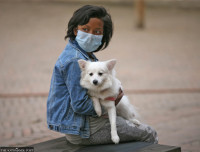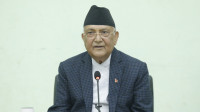Mon, Jan 5, 2026
National
Child dies from diarrhoea. Cholera confirmed in 58 others
Health authorities are struggling to locate the source of the cholera outbreak, with most cases reported in Kathmandu Valley.
bookmark
Post Report
Published at : August 20, 2024
Updated at : August 21, 2024 07:10
Kathmandu
A four-year-old child from ward 1 of Diprung Chuichumma Rural Municipality of Khotang district succumbed to a diarrheal infection on Sunday evening.
Health workers at the district hospital said all their efforts to save the boy were unsuccessful, as he was brought to the hospital only when his condition had deteriorated.
“Family members delayed taking the child to the hospital because another child in the family recovered from diarrhoea at home without medical treatment,” said Keshav Kumar Khatri, chair of ward 1 of the rural municipality. “Two other members of the same family, who also were infected with diarrhoea, were taken to a nearby health post after health workers learned about the situation.”
Diarrhoeal disease is a common and seasonal public health concern, usually triggered due to unsafe food, water, or poor hygiene. It remains one of the leading causes of morbidity and mortality among young children in Nepal.
According to a report by the Ministry of Health and Population, four deaths of children under five from diarrhoea were recorded in the fiscal year 2022-23, whereas 34 deaths were reported in 2021-22.
Amid ongoing monsoon rains, most districts have witnessed a spike in diarrheal cases. At least four districts–Kathmandu, Lalitpur, Kailali and Pyuthan–have been witnessing a massive cholera outbreak.
According to the Epidemiology and Disease Control division, at least 58 people have tested positive for cholera this year. Of the 58 people, 48 are from Lalitpur (41) and Kathmandu (7). Eight others were from Kailali, and two were from Pyuthan district.
Cholera is a highly infectious disease that causes severe diarrhoea and vomiting, leading to dehydration and even death within a few hours if untreated. The World Health Organisation says cholera is a global threat to public health and an indicator of inequality and a lack of social development.
Health officials said that the Vibrio cholera 01 Ogawa serotype has been confirmed in the stool samples of the infected patients.
Cholera outbreaks during the monsoon season are not new in Nepal, as diarrhoeal infections affect hundreds of people throughout the country every year, with outbreaks often lasting for months.
Public health experts said that the reported cases of cholera could be just the tip of the iceberg, as most of the positive cases are being reported from the districts with active surveillance, including the three districts of the Kathmandu Valley and Kailali, while most others lack such systems entirely.
Health officials in the Kathmandu Valley said they are still struggling to pinpoint the source of cholera.
“Seven people tested positive for cholera and are from seven different places,” said Dr Arjun Sapkota, chief of the Health Office Kathmandu. “We have deployed health workers to collect drinking water samples but have not found traces of cholera bacteria.”
Hazardous microbes including E coli and faecal coliform have been detected in most water sources, including in samples of bottled water, health officials say.
E coli and faecal coliforms are microscopic organisms that live in the intestines of warm-blooded animals or their faeces. Their presence means that the drinking water is contaminated with sewage.
Public health experts say that due to poor sanitation and hygiene conditions, the country as a whole is highly vulnerable to water-borne illnesses, including diarrhoea, dysentery, typhoid, hepatitis, and cholera, with thousands of people getting infected every year.
They say sheer negligence from authorities concerned is responsible for the ongoing outbreak of diarrhoeal diseases, including the deadly cholera.
Health authorities in most local units had stopped testing drinking water just before the start of the monsoon season, citing a lack of funds, although deadly microbes such as faecal coliforms and E coli were frequently detected in drinking water samples.
Doctors say the most effective ways to prevent people from dying from water-borne diseases, including diarrhoea, are to raise awareness and ensure safe drinking water.
They say a combination of careful surveys, safe drinking water, sanitation and hygiene, social mobilisation, and treatment are required to contain the spread of diarrhoeal infection.
According to the World Health Organisation, diarrhoea is the second leading cause of mortality in children under five. The disease has also been linked with growth and cognitive shortfalls in children, especially in marginalised communities.
The UN health body has also said that a multifaceted approach is key to controlling cholera and reducing deaths.
Most Read from National
Balendra Shah intensifies political engagements, meets Lamichhane, Ghising and others
After China, US recalls its ambassador to Nepal
Kathmandu administration denies permission for Gen Z protest, demonstrators dispersed
Students allege British College misled them on ‘overseas courses’
‘Like a dream’: Labourer from Dalit community secures full MBBS scholarship
Editor's Picks
Nepal’s workplaces still fail new mothers
When will Nepali-origin professional footballers in Europe play for Nepal?
‘Like a dream’: Labourer from Dalit community secures full MBBS scholarship
Why Nepal is launching a system to track foreign nationals
Nepal achieves global vaccine target, seven years ahead of schedule
E-PAPER | January 05, 2026
×




 5.39°C Kathmandu
5.39°C Kathmandu









%20(1).jpg&w=300&height=200)



